|
|
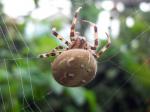
|
4 Spot Orb-weaver
|
|
Special features: Four spot orb weavers (Araneus quadratus) are fairly common. They can be found throughout the U.K. in the summer and autumn months. |
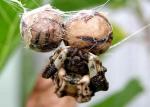
|
Bird Dropping Spider
|
|
Description
The Bird Dropping spider has a body that looks like bird droppings. This protects them from being eaten by predators such as birds and wasps. |
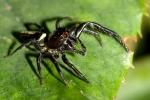
|
Biting Jumping Spider
|
Description
The Biting Jumping Spider is shiny black in colour, with a pale patch on the back of the head and a pale stripe down the centre of the abdomen. It has large eyes and the first pair of legs are strong with spines for catching prey. The eyes are arranged in two rows and the first pair are large and forward facing. They build no web but often construct silk sacs to rest and moult. |
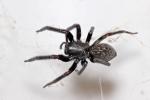
|
Black House Spider
|
Description
The Black House Spider has dark brown to black carapace and legs. The abdomen is charcoal grey with a dorsal pattern of white markings |

|
Black Wishbone Spider
|
Description
The Black Wishbone Spider is a medium to large black spider with large downward pointing fangs. their burrow is d like a wishbone. The burrow is near vertical and lined with silk and sometimes branched into a y-shape or wishbone shape. This is why they are called wishbone spiders. The burrow does not have a trap door. The spider sits at the entrance and pounce on passing prey. |
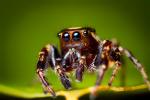
|
Bronze Jumping Spider
|
Description
Helpis jumping spiders are shades of brown and cream. They often hide in their retreat in a curled up leaf and ambush passing insects. |

|
Brown Huntsman Spider
|
Description
The Brown Huntsman is a large spider patterned in brown and black. It has crab-like legs, and is fast moving. |
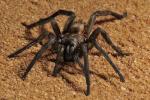
|
Brush-footed Trapdoor Spider
|
Description
Brush-footed Trapdoor Spiders belong to the Barychelidae family. They live in burrow with a trapdoor under leaf litter, or against tree roots or rocks. The species shown here is khaki-brown coloured with mottled markings on the abdomen. |

|
Cave Spider
|
|
Special features: There are two large brown coloured cave spiders found in the U.K.; Meta menardi and Meta bourneti. The two can only be distinguished by examining them with a strong magnifier. |
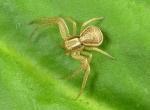
|
Cm. Crab Spider
|
|
Special features: As the name suggests, Common Crab spiders sometimes move in a crab-like way, from side to side. The longer pairs of front legs are also reminiscent of crabs. |
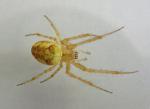
|
Cm. Orb-weaver
|
|
Special features: The female common orb weaver is a pale yellow-brown colour. The abdomen features brown markings which resemble a leaf pattern. |
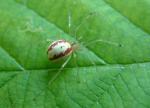
|
Comb-footed Spiders
|
|
Special features: The comb-footed spider produces a scrappy web consisting of a loose network of criss-cross threads. |

|
Crab Spider
|
Description
The Crab Spider rests with its first two pairs of legs pointing forward. This makes it hard to see when it is resting on a twig. |
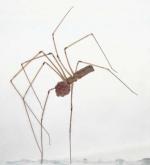
|
Daddy Long Legs Spider
|
Description
The Daddy Long Legs Spider has very long thin legs and is often seen in undisturbed areas in and around the house. When disturbed, the spiders vibrate their web. |

|
Dew Drop Spider
|
Description
The Dew Drop Spider is a small spider with shiny silver abdomen , making it look like a drop of dew. It is often found on the web of the Golden Orb Weaver spider. |
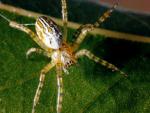
|
Dome Web Spider
|
Description
The Dome Web Spider builds a dome shaped web that looks like a large inverted saucer with tangle of web above and below. The spider sits above the dome. The dome may be 50 cm in diameter. The body of the spider is black and white with rusty red stripes down the back. The head is grey and the legs are grey with black bands. |
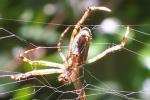
|
Enamelled Spider
|
Description
The Enamelled Spider has an enamelled appearance which varies in colour in different parts of the country. Some spiders are a pure green colour. It is active in its web at night where it waits for small flying insects to get caught in the orb web placed about a metre above ground level. The spider retreats to surrounding vegetation during the day. |

|
False Widow - Steatoda grossa
|
|
Special features: The abdomen of this false widow is a red-brown colour with a crescent shaped stripe at the front and three pale triangular spots along the top. These markings vary from spider to spider. Sometimes they're cream coloured and sometimes they're purple or very dark brown. |
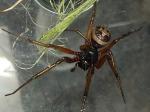
|
False Widows
|
|
Special features: The false widow spider (Steatoda nobilis) probably arrived in the UK from the Canary Islands. It was first recorded in Torquay, Devon, back in 1879. Since then it has adapted well to our colder climate. |
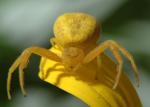
|
Flower Spider
|
Description
There are probbaly several species of Flower Spiders shown on this page. Let me know if you can identify any of them. Most have colour combinations of green, yellow, red and white. The head and legs are generally green or white, and abdomen is yellow or white. |
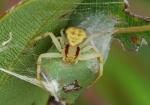
|
Flower Spider ( Zygometis lactea )
|
Description
This spider is creamy white in colour with brownish red markings on each side of the head (the cephalothorax), and on the front part of the abdomen. The male has dark bands on the legs. |
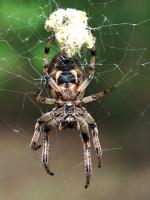
|
Furrow Orbweaver
|
|
Special features: The colour of Furrow Orbweaver Spiders can be extremely variable. Young spiders and males tend to be more brownish in colour, with older specimens, and females being more greyish. There is always a dark, V-shaped mark at the rear of the abdomen. |
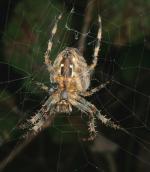
|
Garden Centre Spider
|
|
Special features: The Garden Centre spider (Uloborus plumipes) was only recently introduced to England inside exotic potted plants. It can be recognised by it's two humped, triangular abdomen, and it's long, 'plumed' (hairy) front legs. When resting on its web the Garden Centre Spider typically leaves its front pair of legs stretched out in front of its body. It is sometimes called the "Feather-legged lace weaver". |
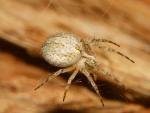
|
Garden Orb Weaver Spider (Eriophora sp)
|
Description
Garden Orb Weavers are stout, reddish-brown or grey spiders with triangular abdomen. The Garden Orb Weavers build large, strong, vertical orb webs. The web is usually built in the evenings and taken down again at dawn. The spider rests head-down in the centre of the web during darkness, waiting for prey. During the day, the spider rests under nearby branch or in nearby foliage with its legs drawn under the body. |
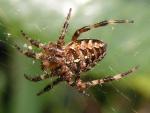
|
Garden Spider
|
|
Special features: Garden spiders are sometimes called Cross spiders on account of the white '+' cross-shaped mark on the abdomen. They're most frequently seen in September and October, when they reach adult size. |
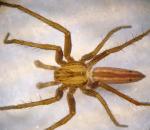
|
Grass Spider
|
|
Special features: Gets its name from it's preferred habitat among tall grasses. The Latin name 'oblongus' is derived from the elongated body shape. |
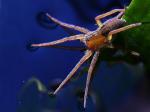
|
Great Raft Spider
|
|
Special features: Great Raft Spiders (Dolomedes plantarius), also known as Fen Raft Spiders, have a brown or black coloured body, usually with a distinctive cream coloured stripe running along both sides of the body, although this is not always present. |

|
Green Orb-weaver
|
|
Special features: Despite its almost florescent green colour the Green Orb-weaver can remain very well camouflaged amongst vegetation. |
|
|